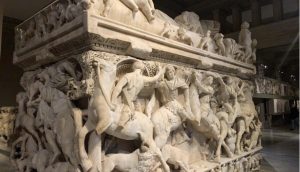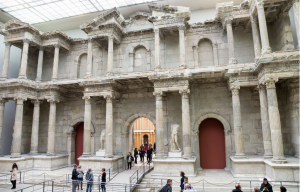From the rise of the Roman Empire to the fall of the Ottoman Empire, Istanbul served home to many emperors and various societies. The history of the city is extremely complex as it reflects the architecture and cultures of primarily the Greeks, Italians, French and Turkish. Istanbul Archaeological Museums displays the true history of Turkey through mythological sculptures and historical/geographical development of the country. If you want to dispose of the tainted picture of Turkey painted by the Western media, you sure should read this.
The Istanbul Archaeological Museums
Istanbul Archaeological Museums is considered as the first museum of Turkey and it has been around since 1891. This one-of-a-kind museum has a large collection of sculptures and art antiquities, containing more than 1 million artifacts, which date back to 5000 years ago and has been growing ever since. This is possible thanks to the recent effort made to take back all the stolen relics from the Ottoman Empire times. The exhibition exists of three buildings; Istanbul Archaeological Museum, the Ancient Orient Museum and the Tiled Kiosk Museum which is also called the Museum of Islamic Art. The archaeologist Osman Hamdi Bey was appointed as the museum director in 1881, and has conducted excavations in ancient cities like Myrina, Kyma, Lagina and areas like Lebanon and Mount Nemrut. Most of the world-famous artifacts like Alexander the Great’s Sarcophagus, which is displayed in the museum, were uncovered and collected by him.

Lara Gunturkun
Istanbul Archaeology Museums was being renovated and restored, yet in July 2022 the museum opened its doors to the new exhibition halls and rearranged collection. This way, all of the different parts of this museum explain the way Anatolian civilizations have changed throughout the years by using written texts and categorizing the antiquities by ages and areas. Visiting the whole museum will make you feel as if you have travelled into the past and relive the experiences of the ancient Anatolians.
Is Turkey as Middle-Eastern as You Think It Is?
When it comes to countries like Turkey, the relics left by the Roman Empire are forever dismissed and pledged ownership by the Western world. Turkey hosted a home to several mythological and historical individuals like Artemis, Aphrodite, Hermes, Zeus, Alexander the great, Julius Caesar, and even the Trojan horse of the Ancient City of Troy is in Turkey. However, current media lacks focus on this part of Turkish history and expresses the recent-Islamic part of the Ottoman Empire times. Yet, they exceptionally ignore the fact that at the time Turkish culture and the lifestyle of West Turkey was heavily influenced by the Byzantine Empire as Istanbul was the capital of the East Roman Empire.
This perceived disconnection is rooted in ideological policies of Western cultural supremacy that have come to dominate all academic fields in the early 20th century. Even the term “Middle-East” has aimed to reduce the region and its people to homogenous and alienated sentiments. Nevertheless, archaeological evidence combined with modern cultural practices serve us as reminders that history is not as one-sided as one might believe. The history of Turkey which is told by the antiquities in Istanbul, and it’s full of first-hand evidence, will surely prove the outdated colonialist and orientalist approach to be false.
The Stolen History of Istanbul
Over 150,000 antiquities have been smuggled and more than a quarter of them are getting displayed in historical museums abroad. Primarily, most of them are in the British Museum (London) since, in the 1840s, the British stole many artifacts from the ancient city of Xsanthos (Antalya). Several excavations have also been led by Germany during the Ottoman Empire era. During these times about 10,000 antiquities were taken for restoration but were never returned. A great example is the Market gates of the ancient city of Miletus (Western Turkey), which was wholly stolen and is currently displayed at the Pergamon museum in Germany (Berlin). A part of Sidamara Sarcophagus had also been illegally taken away by the British military consul general Charles Wilson in 1882 and was displayed at the Victoria & Albert Museum. As it is the world’s heaviest sarcophagus (32 tons), the military could not take back the whole artifact, so they extracted Eros’ head and took it to London. In June 2022, with the cooperation of the Victoria & Albert Museum, the Sidamara Sarcophagus and Eros’ head were returned to Istanbul Archaeological Museums.

In 1906, Osman Hamdi Bey, the founder of Turkish museology, brought in the Law of Antiquities of the Ottoman Empire which prohibited cultural artifacts from being transported abroad and gave the state the ownership of all the antiquities on Turkish land. Despite this law, the illegal excavations continued which encouraged Halil Ethem Eldem, Osman Hamdi Bey’s brother, to retrieve the stolen artifacts in the 1920s. This started the first repatriation of historical artifacts that were found around the Kingdom of Lydia (Sardis), currently Western Anatolia, from the Metropolitan Museum (the US). Such efforts to discourage the thieving of such cultural antiquities still continue, as in January 2021, Turkey made an agreement with the US and Germany so that all Turkish artifacts that entered these countries would be illegal. In the past 10 years, 2,712 antiquities have been returned to Turkey, however this is just the tip of the iceberg.
Visit for an Unforgettable Trip!
If you happen to come to Istanbul, or plan on going on a vacation in the popular Turkish tourist cities of Antalya, Cappadocia or Pamukkale, make sure to stop by the Istanbul Archaeological Museums. Although all of these popular cities have magnificent views and beautiful nature spots, you must go to this part of Istanbul if you want to see the true history behind the lifestyle of Turkish people. You can also find the Basilica Cistern (Yerebatan Sarnıcı), Hagia Sophia Museum and Topkapi Palace Museum in the surrounding area which also should be on your to-go list when coming to Turkey. All of these museums might sound boring to a person who is not interested in art or history, but you should give it a chance anyways because – you never know – you might fall in love with the mythology reflected from the past to current Turkey and gain a new perspective of your known reality.
Cover: Hilal Dolovac
Editor: Luca Rietkerk





